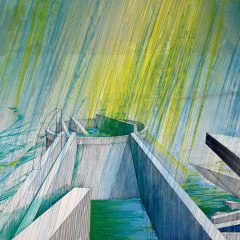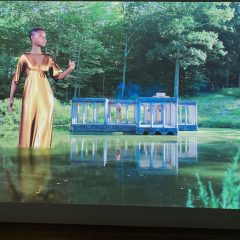There’s more than meets the eye in Vanitas: Contemporary Reflections at the Philadelphia Art Alliance, which, true to its name, is about to expire–at the end of today (Aug. 12, 2010).
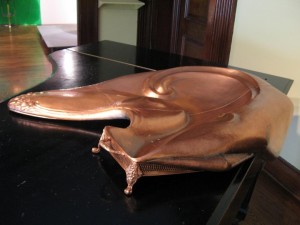
The five artists in the show wrestle with decoration and/or the domesticity, but it’s the works that struggle with the failure of decoration to stave off the facts of life and death that are the most inspired.
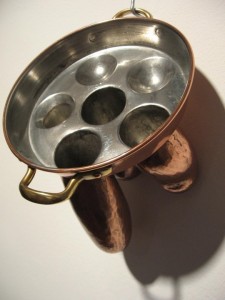
Myra Mimlitsch-Gray’s excellent metal sculptures begin with found, fancy metal utensils and servers that she transforms to suggest a threat that no amount of housekeeping or propriety can overcome. Escargot cups hang like testicles, and a chafing dish overflows with an invasive tongue. Mimlitsch-Gray (New Paltz, NY) showed a year ago at Wexler Gallery, but I don’t remember the frisson of danger that’s in the works here, the sense of skeletons in the closet and dust swept under the rug.
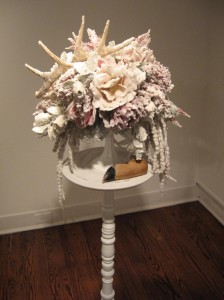
I swore never again to write about art work with dying deer symbolic of a lost environmental paradise, but Katherine Kaminski (Peoria) convinced me with her kitsch-inspired sculptures of sugar-coated funerary arrangements. A deer heart sculpture under a bell jar embedded in a sugary Victorian bouquet is shocking. In the drawings, the deer and the dear little girls take on each other’s identities and the scenarios contain surreal elements. That these drawings, which would be right at home in Art Star, overcome their kitsch conventions–skulls, hearts and flowers, not to mention deer–is a credit to Kaminski.
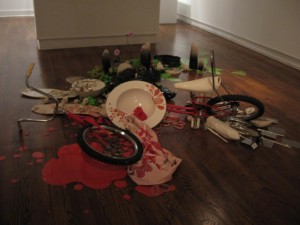
While Philadelphia artist Candy Depew has always suggested the fragility of life and the body with her decorated porcelain skulls and delicate gestural decorations, here she takes on depth, confronting death and the ways, honest and dishonest, that people memorialize others. Her Stilled Life installation is a bicycle- and skateboard-crash, with decorative pools of blood scattered at the crash site. Behind the remnants of the crash is an artful version of the stuffed-animal stelae that grow into dismal, rain-soaked mounds on our city streets. Depew captures at once the grief, the failure of these gestures to overcome it, and the cultural phenomenon that has made this outpouring fashionable. The room itself evokes a darkened funeral parlor, decorated with Depew’s usual baubles, which call into question the whole urge to decorate our path to the grave.
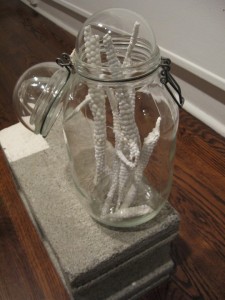
Less satisfying are Brooklyn artist Audrey Hasen Russell’s stacked, blown glass pileups, the potential to suggest domestic fragility undermined by a visual stinginess and tentativeness. Only her White Stick Jar with mysterious white objects inside, resting on a cinderblock partially painted white, made me stay to think.
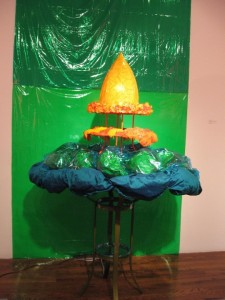
New York area artist Savannah Gae decorates a boy phallic missile and its explosion into domestic complacency, a nuclear tuffet. I got a Middle Eastern vibe from its architectural form. But it’s nearly lost in the room between two other pieces–girly cakes about 5 feet in diameter and 7 or 8 feet high–extreme dressing tables, piled high with boxes and crowned and draped like four-poster beds with fabric and cellophone. The hair clips and beads, the colors and glitz, suggest teenage girls unaware of the ephemeral nature of their beauty as they play at reinventing themselves with makeup and fashion. But like the girls, these pieces feel as if they are incomplete, even with their layers of gewgaws and spectacle.


